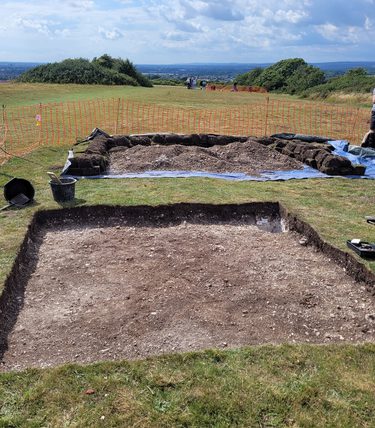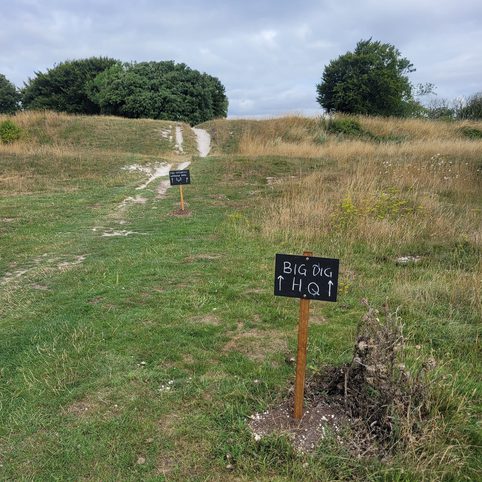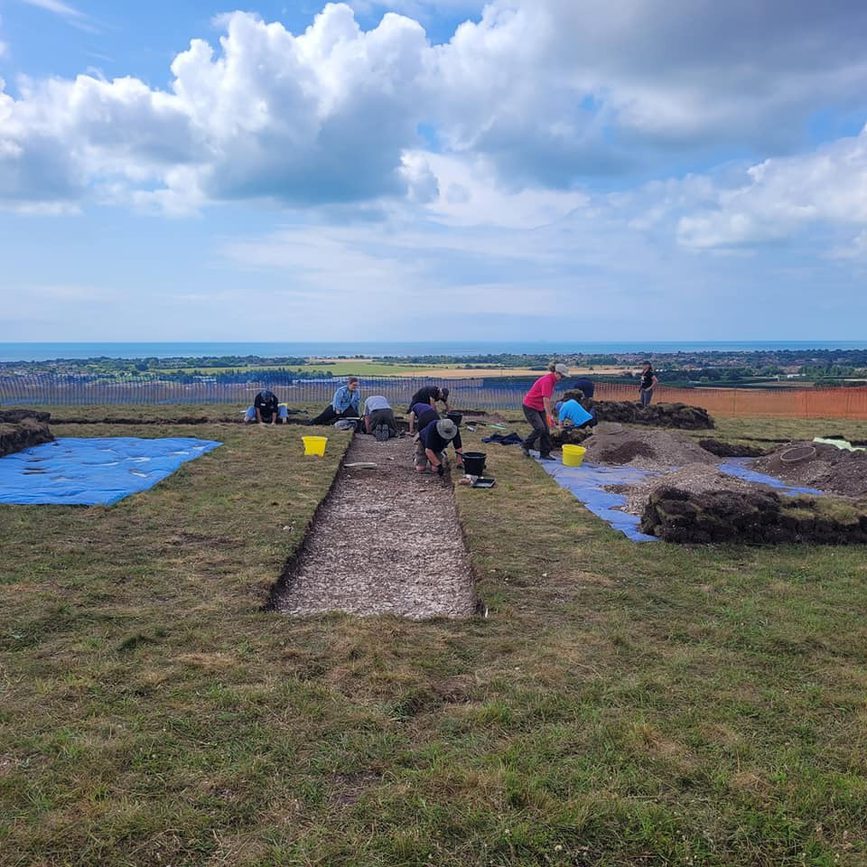
News Story
High above the Sussex coast, history is being uncovered. The Highdown Big Dig 2025, led by our Archaeology Curator James Sainsbury, has not only revealed remarkable insights into the ancient life and landscape of Highdown Hill but also brought our local community together in a shared exploration of our past.
Over the first six days of excavation, a dedicated team of archaeologists, volunteers, metal detectorists, and visiting specialists have worked tirelessly to uncover stories from the Bronze Age to the Second World War. With hundreds of visitors daily, the site has become a centre of public engagement, education, and discovery, enlightening all who visit.
Here’s a look back at the first week of buried history revealed…
Day One: Breaking Ground on Highdown Hill
Despite a soggy start, the team opened several trenches across the hill.
- Trench H targeted a possible Bronze Age burial mound, believed to date back to around 1500 BC.
- Trench G was deturfed for later OSL (Optically Stimulated Luminescence) analysis by Newcastle University.
- The metal detecting team began their sweep of the hill, already revealing a Roman ring fragment and a clog clasp - early hints of the site’s layered past.

Day Two: Early Finds and Growing Crowds
Visitors flocked to the Big Dig HQ, where archaeologists shared their latest discoveries:
- Two human finger bones were found in Trench H, possibly from a later secondary Anglo-Saxon burial.
- Trench A was opened today, and we have discovered Iron Age pottery sherds and two beads - the age of which is unknown but possibly prehistoric.
- In Trench B, cleaned in preparation for osteological analysis, hopes were high for uncovering Anglo-Saxon graves.
- Detectorists found a 1st-century AD Roman brooch and several military badges from both World Wars.
Day Three: Schools, Skeletons and Scrutiny
A blustery but fruitful day saw over 200 school children from Durrington Primary explore the dig.
- Trench B delivered a cow vertebrae and early Roman pottery.
- Trench C, newly opened outside the western ramparts and ditch, revealed prehistoric pottery and worked flints.
- Metal detectorists discovered coins from George II and George V, and Trench G surpassed 150 labelled finds.
Watch a stunning video overview of the site, courtesy of local archaeological photographer Antonio Reis from University College London (UCL) , here.

Day Four: Saxon Graves and Roman Riches
With visitor numbers soaring and tours packed, the archaeology stepped up:
- Trench B appeared to contain up to three Anglo-Saxon graves, and a beautiful Iron Age glass bead was recovered from the spoil heap.
- Trench H produced a human tooth, adding to the mystery of the potential barrow.
- Trench G, we had two Roman coins and more finds.
See more in our daily video update here.
Day Five: Confirming Graves and Uncovering Wealth
Now with over 1,000 visitors in just five days, the dig has uncovered more breakthroughs:
- At least one confirmed Saxon grave cut, plus potential cremation pits, were identified in Trench B.
- A silver coin from 20 BC - 20 AD, a rare Late Iron Age ‘silver unit’, was discovered in Trench H.
- Trench G revealed chalk bedrock. Mike Allen will be on site tomorrow to take environmental samples, which will tell us when the lynchet was farmed and what landscape it was constructed in.
- Metal detecting uncovered more 4th-century Roman coins and an Anglo-Scandinavian zoomorphic mount.
- Workshops and tours reached record numbers, with over 100 children participating.
Image gallery
Day Six: Crystal Beads and Victorian Shadows
History took a fascinating twist in Trench B, where Victorian archaeologists had left their mark:
- Fragments of human bone from earlier digs were found within a Saxon grave cut, alongside a stunning rock crystal bead, which had been overlooked for over a century.
- Trench H may now be a rare example of a turf barrow, evidenced by Neolithic and Bronze Age flint tools and deliberate whelk deposits.
- Trench G, once thought to be a lynchet or field bank in the traditional sense, may mark an ancient famed/lived boundary.
- Finds included more 4th century Roman coins and fragments of what could be a Late Bronze Age hoard.
Explore the latest discoveries in our sixth-day video update here.
Visit, Learn and Discover at the Big Dig
The Highdown Big Dig continues with daily tours, children’s workshops and new trenches opening as the mystery deepens. Explore more and plan your visit:
Help Us Reimagine Worthing Museum
Projects like the Highdown Big Dig show how archaeology connects us all to our shared history. But to continue uncovering, preserving, and sharing these stories, Worthing Museum needs your support. Your involvement is integral to our mission.
Through the Reimagining Worthing Museum campaign, we’re transforming how our collection is cared for, displayed and experienced for future generations. Your donation will help bring more stories like Highdown’s into the public eye, through modern galleries, inclusive interpretation and expanded learning opportunities.
Together, we can keep history alive, one discovery at a time.


